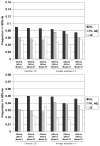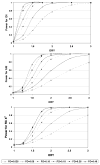Performance of reclassification statistics in comparing risk prediction models
- PMID: 21294152
- PMCID: PMC3395053
- DOI: 10.1002/bimj.201000078
Performance of reclassification statistics in comparing risk prediction models
Abstract
Concerns have been raised about the use of traditional measures of model fit in evaluating risk prediction models for clinical use, and reclassification tables have been suggested as an alternative means of assessing the clinical utility of a model. Several measures based on the table have been proposed, including the reclassification calibration (RC) statistic, the net reclassification improvement (NRI), and the integrated discrimination improvement (IDI), but the performance of these in practical settings has not been fully examined. We used simulations to estimate the type I error and power for these statistics in a number of scenarios, as well as the impact of the number and type of categories, when adding a new marker to an established or reference model. The type I error was found to be reasonable in most settings, and power was highest for the IDI, which was similar to the test of association. The relative power of the RC statistic, a test of calibration, and the NRI, a test of discrimination, varied depending on the model assumptions. These tools provide unique but complementary information.
Copyright © 2011 WILEY-VCH Verlag GmbH & Co. KGaA, Weinheim.
Conflict of interest statement
The authors have declared no conflict of interest.
Figures





References
-
- Adult Treatment Panel III. Executive Summary of The Third Report of The National Cholesterol Education Program (NCEP) Expert Panel on Detection, Evaluation, And Treatment of High Blood Cholesterol In Adults (Adult Treatment Panel III) JAMA. 2001;285:2486–2497. - PubMed
-
- Ash A, Shwartz M. R2: a useful measure of model performance when predicting a dichotomous outcome. Statistics in Medicine. 1999;18:375–384. - PubMed
-
- Cook NR. Use and misuse of the receiver operating characteristic curve in risk prediction. Circulation. 2007;115:928–935. - PubMed
-
- Cook NR. Comments on ‘Evaluating the added predictive ability of a new biomarker: from area under the ROC curve to reclassification and beyond’. Statistics in Medicine. 2008;27:191–195. - PubMed
Publication types
MeSH terms
Grants and funding
LinkOut - more resources
Full Text Sources

